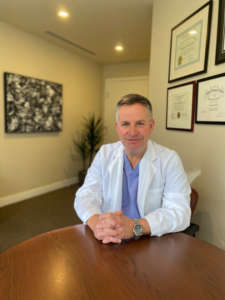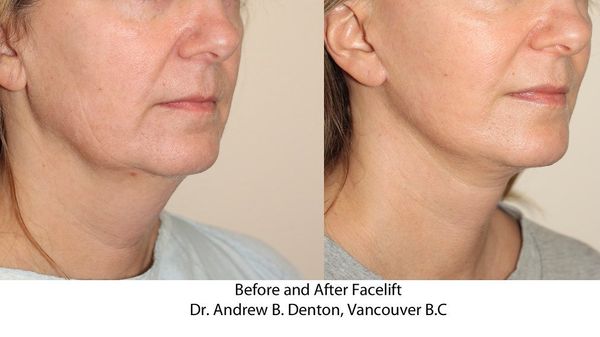The desire for a refreshed, youthful appearance often leads people to consider facial rejuvenation procedures. While terms like “facelift” and “mini facelift” are commonly used, the concept of a “partial facelift” may be less familiar. As a board-certified facial plastic surgeon in Vancouver with over two decades of experience, Dr. Denton would like to explain what a partial facelift entails and help you determine if it’s the right option for your unique needs.
What is a Partial Facelift?
A partial facelift, in essence, is a tailored approach to facial rejuvenation that focuses on specific areas of the face, offering a less invasive solution than a traditional facelift while still achieving significant improvements. This technique can address the signs of aging that are localized in specific areas, providing a more focused approach to enhancing your natural beauty.
The Partial Facelift Procedure
A partial facelift, unlike a full facelift, targets specific regions of the face, addressing concerns such as sagging jowls, nasolabial folds, and loose skin in the lower face and neck. The procedure involves making strategic incisions, usually around the ears, to access the underlying tissues. The surgeon then lifts and tightens the muscles and tissues, removing excess skin as needed.
The specific techniques used can vary depending on the patient’s individual needs and goals. In general, the goal is to restore a more youthful contour to the lower face and neck while maintaining a natural-looking appearance. Partial facelifts do not address the upper face to any significant degree, so they won’t lift the brow or eyelids. The procedure is performed in our fully accredited operating room under twilight anesthesia.
When to Consider a Partial Facelift
Deciding whether a partial facelift is right for you depends on the extent and location of your concerns. Generally, if you’re noticing:
- Sagging skin and jowls: Primarily around the lower cheeks and jawline
- Deepening nasolabial folds: The lines from the nose to the mouth become more prominent
- Mild to moderate neck laxity: Loose skin or “banding” under the chin and in the upper neck
A partial facelift could be a good fit and especially beneficial for individuals who are experiencing signs of aging in the lower face and neck, but not in the midface or forehead. This targeted approach allows for significant improvement without the need for a full facelift, making it a suitable option for those who seek a less extensive surgical solution. It’s important to have a consultation with a facial plastic surgeon to see if this procedure is right for you.
Ideal Candidates for Partial Facelifts
The best candidates for partial facelifts typically share these characteristics:
- Age range of 40-55 years
- Good skin elasticity
- Localized concerns about sagging in the mid-face or jawline
- Realistic expectations about results
- Good overall health
- Non-smokers or willing to quit before surgery
- Looking for a less invasive option than a full facelift
Partial vs. Mini vs. Full Facelift: What’s the Difference?
Understanding the distinctions between a partial, mini, and full facelift is essential to make an informed decision.
Mini Facelift
A mini facelift is often described as a less invasive version of a full facelift. It involves smaller incisions, typically around the ears, and focuses on lifting and tightening the lower face and neck. While it can address jowls and mild neck laxity, the results may not be as dramatic as a partial or full facelift. Mini facelifts are ideal for people with mild to moderate signs of aging.
Full Facelift
A full facelift addresses the entire face, including the mid-face, lower face, and neck. It involves longer incisions and more extensive tissue manipulation. Full facelifts are best for individuals who are experiencing significant aging across multiple areas of the face and neck.
A partial facelift, as the name implies, falls in between the mini and full, targeting a specific portion of the face and addressing a certain set of issues in a way that is still quite comprehensive.
The Surgical Technique: An Expert Perspective
The success of a partial facelift, or any facial plastic surgical procedure, can be determined by your surgeons knowledge of facial anatomy and skillful surgical techniques. Dr. Denton uses what is referred to as the deep plane or SMAS technique (superficial musculoaponeurotic system). This facelift technique goes beyond simply tightening the skin, it involves manipulating the deeper layers of tissue, allowing for more dramatic, long-lasting results.
The SMAS lift helps to elevate the deep layers of the face, providing a more natural-looking result by repositioning tissue that has descended with age. This technique is crucial in partial facelifts as it allows for targeted changes in specific areas while avoiding an unnatural, stretched look. Also, Dr. Denton makes incisions that are hidden within the natural creases of the face in order to minimize visibility.
What to Expect During a Partial Facelift
The partial facelift procedure typically takes one to two hours, and is performed under twilight anesthesia. During the surgery, Dr. Denton will carefully make the necessary incisions, lift the underlying tissues, and remove any excess skin. Once the procedure is complete, a light dressing may be applied. You’ll be monitored in our recovery area before being discharged to go home. If patients experience minimal pain, Dr. Denton may prescribe pain medications. Swelling and bruising can be expected initially, but these symptoms will typically resolve within a week or two.
Recovery and Aftercare
The recovery period following a partial facelift is generally shorter than that of a full facelift. Swelling and bruising are common during the first few days, but will gradually subside. A tape dressing is placed following surgery and is kept in place for one week. Most of our patients can return to work within one to two weeks.
It’s essential to follow all post-operative instructions carefully to ensure proper healing and minimize the risk of complications. These instructions will include guidelines on wound care, activity restrictions, and medication usage. We also offer post-operative follow-ups to monitor your progress and address any concerns.
Combining Procedures for Comprehensive Rejuvenation
While a partial facelift can provide significant improvement to the lower face and neck, it may be beneficial to combine it with other procedures for a more comprehensive facial rejuvenation. For example, an eyelid lift, or blepharoplasty, can address the signs of aging in the upper face. A brow lift can also enhance the upper face by restoring the youthful position of the eyebrows.
Sometimes, a partial facelift can be combined with facial liposuction in order to remove excess fat and enhance facial contours. Additionally, injectable treatments such as Botox or fillers can smooth wrinkles and restore lost facial volume to enhance the results of a partial facelift. In a consultation, Dr. Denton can assess your specific needs and determine if combining procedures would help you meet your goals for facial rejuvenation.
Frequently Asked Questions about Partial Facelifts
Q1. How long will the results of a partial facelift last?
While a partial facelift can provide long-lasting results, the aging process will continue. On average, a partial facelift may provide 7 to 10 years of rejuvenation. Maintaining a healthy lifestyle and skincare routine can help prolong the results.
Q2. Will I have visible scars after a partial facelift?
Incisions are made within the natural creases of the face and behind the ears, to minimize the visibility of scars. The scars will fade over time.
Q3. How much does a partial facelift cost?
The cost of a partial facelift in Vancouver varies based on factors such as the complexity of the procedure and the surgeon’s experience. On average, it ranges from $8,000 to $15,000. It’s important to get a detailed quote during your consultation to understand what is included in the pricing.
Choosing the Right Surgeon: Key Considerations
Selecting the right facial plastic surgeon is crucial for achieving the best possible results. When considering a partial facelift, make sure to prioritize the following:
- Expertise and Experience: Ensure your surgeon is board-certified Facial Plastic Surgeon with years of experience in facelift procedures.
- Aesthetic Sense: Look at before and after photos to see if your surgeon’s aesthetic aligns with your goals.
- Personalised Approach: Your surgeon should take the time to listen to your goals and develop a tailored treatment plan.
- Patient Reviews: Reading patient reviews and testimonials can give you a sense of the surgeon’s reputation and the overall patient experience. Positive feedback from previous patients can help you feel more confident in your choice.
Why Choose Dr. Denton for Your Partial Facelift in Vancouver?

He is committed to helping you feel confident and comfortable throughout your surgical journey, from your initial consultation to your post-operative follow-up. At his private and fully accredited surgical facility in Vancouver, he utilizes the most advanced computer imaging software to help patients visualize the anticipated results. This tool ensures you can make a well-informed decision about your procedure. He and his team strive to provide our patients with a welcoming and supportive atmosphere for a positive surgical experience.
If you are considering a partial facelift, schedule a consultation with Dr. Denton today. Together, you can discuss your specific goals and develop a personalised plan to achieve your desired outcome.

